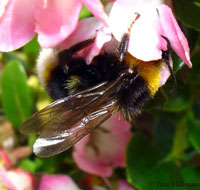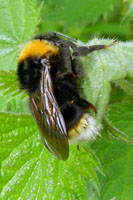Gypsy Cuckoo Bumble Bee
Scientific name: Bombus bohemicus


Cover photos credit: Pete Hillman
Status
Endangered
“Endangered” means the species lives in the wild in Ontario, but is facing imminent extinction or extirpation.
Date added to the Species at Risk in Ontario List
March 31, 2015
Read the assessment report (PDF)
What it looks like
The Gypsy Cuckoo Bumble Bee is a medium-sized bumble bee.
Both females and males range from 12-18 mm in length with a white-tipped abdomen and similar colour pattern. Unlike most bumble bees, cuckoo bumble bees lack “pollen baskets” on their hind legs, as cuckoo bumble bees do not bring pollen back to their colony.
This bee does not produce workers as they are a parasite bee and take over existing colonies of other bumble bees.
Where it lives
The Gypsy Cuckoo Bumble Bee is a holarctic species known to occur around the globe in Europe, Asia and North America.
In Canada, the Gypsy Cuckoo Bumble Bee has been recorded in every province and territory except Nunavut and occurs in diverse habitats such as open meadows, agricultural and urban areas, boreal forest and woodlands.
This bumble bee is thought to eat the pollen and nectar of a wide variety of plants.
Gypsy Cuckoo Bumble Bees are a parasitic species which follows the life cycle pattern and therefore, in part, the habitat of its hosts which are other bumble bees (e.g., the Rusty-patched and Yellow-banded Bumble Bees).
Where it’s been found in Ontario
In Ontario, the Gypsy Cuckoo Bumble Bee was historically found throughout most of the province; however in recent years it is known only to occur in Pinery Provincial Park.
Despite recent search effort, few Gypsy Cuckoo Bumble Bees have been observed in the last 20 years in Ontario. Due to its decline across Canada, it is now only known to occur in three provinces based on evidence from recent survey efforts.
What threatens it
The decline of the host species on which it depends is considered the main threat to the Gypsy Cuckoo Bumble Bee.
Additional potential threats, which also affect the Gypsy Cuckoo Bumble Bee’s host species, include pesticide use, introduction of pathogens from managed bee colonies, habitat loss, and climate change.
Action we are taking
The Government of Ontario is working with stakeholders, the public, and other levels of government to develop strategies and plans to address the main stressors that pollinators face and to enhance the health of Ontario’s pollinators and to strengthen their populations.
Endangered species and their general habitat are automatically protected.
Recovery strategy
A recovery strategy advises the ministry on ways to ensure healthy numbers of the species return to Ontario.
Read the executive summary and full document (December 13, 2017)
Government response statement
A government response statement outlines the actions the government intends to take or support to help recover the species.
Read the government response statement (December 21, 2018)
Review of Progress
A review of progress made toward protecting and recovering a species is required no later than the time specified in the species’ government response statement, or not later than five years after the government response statement is published if no time is specified.
Read the report on progress towards the protection and recovery of 11 species at risk, including Gypsy Cuckoo Bumble Bee (2023).
What you can do
Report a sighting
The Ministry of Natural Resources and Forestry tracks species at risk such as the Gypsy Cuckoo Bumble Bee. You can use a handy online form to report locations of colonies to the Natural Heritage Information Centre. Photographs with specific locations or mapping coordinates are always helpful.
Volunteer
Volunteer with your local nature club or provincial park to participate in surveys or stewardship work focused on species at risk.
Consider joining existing citizen science projects to contribute to a ‘virtual’ bumble bee collection, help researchers, or connect with others interested in bumble bee conservation efforts.
Be a good steward
- Private land owners have a very important role to play in species recovery; if you find the Gypsy Cuckoo Bumble Bee on your land, you may be eligible for stewardship programs that support the protection and recovery of species at risk and their habitats.
- Pollinators, such as bees, are in steep decline across the globe and they play a key role in the survival of many of Ontario’s rare plants; for information on how you can help scientists monitor pollinator populations in Ontario.
- To provide nectar and pollen for bumble bees, plant a variety of native flowering plants in your garden; bees need food from early spring to late fall.
- Dandelion flowers are one of the few sources of nectar and pollen for queen bumble bees emerging from hibernation in the spring; consider waiting until other flowers are abundant before mowing your dandelions. Also, leave areas of bare ground, including old rodent burrows, so bumble bees can dig nests. When you help bees live on your land, they help you by pollinating your flowers (e.g., tomato flowers, cherry blossoms).
Report illegal activity
- Report any illegal activity related to plants and wildlife to
1-877-TIP-SMNR (847-7667) .
Quick facts
- The Gypsy Cuckoo Bumble Bee is one of six cuckoo bumble bees known in North America.
- The Gypsy Cuckoo Bumble Bee had one of the largest ranges of all bumble bees in Canada.
- In the spring, female cuckoo bumble bees invade nests of other bumble bees and either kill or injure the resident queen thereby displacing her to use her daughters (workers) to rear cuckoo bumble bee offspring.
- Only mated Gypsy Cuckoo Bumble Bee queens overwinter.
Photo credit: Peter Hillman